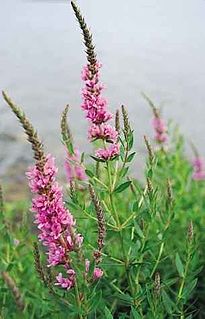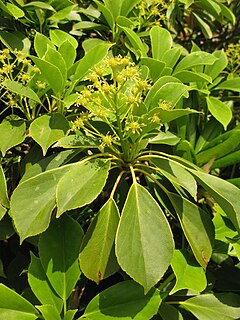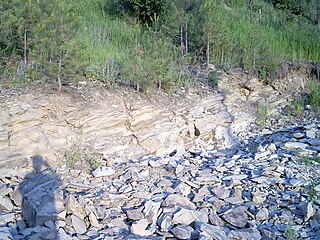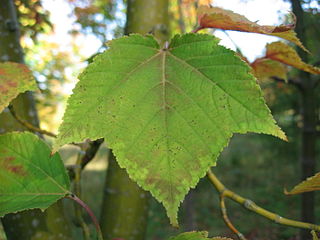
Lythraceae is a family of flowering plants, including 32 genera, with about 620 species of herbs, shrubs, and trees. The larger genera include Cuphea, Lagerstroemia (56), Nesaea (50), Rotala (45), and Lythrum (35). It also includes the pomegranate and the water caltrop. Lythraceae has a worldwide distribution, with most species in the tropics, but ranging into temperate climate regions as well.

Liquidambar, commonly called sweetgum (star gum in the UK), gum, redgum, satin-walnut, or American storax, is the only genus in the flowering plant family Altingiaceae and has 15 species. They were formerly often treated in Hamamelidaceae. They are native to Southeast and east Asia, western Mediterranean and eastern North America. They are decorative deciduous trees that are used in the wood industry and for ornamental purposes.

Altingiaceae is a small family of flowering plants in the order Saxifragales, consisting of wind-pollinated trees that produce hard, woody fruits containing numerous seeds. The fruits have been studied in considerable detail. They naturally occur in Central America, Mexico, eastern North America, the eastern Mediterranean, China, and tropical Asia. They are often cultivated as ornamentals and many produce valuable wood.

Trochodendron is a genus of flowering plants with one living species, Trochodendron aralioides, and six extinct species known from the fossil record. It was often considered the sole genus in the family Trochodendraceae, though botanists now also include the distinct genus Tetracentron in the family.

Dillhoffia is an extinct monotypic genus of flowering plant with a single species, Dillhoffia cachensis known from Ypresian age Eocene fossils found in British Columbia, Canada, and Washington, USA. The genus and species were described from fifteen specimens found in an unnamed formation belonging to the Kamloops group shales; and two specimens from the Klondike Mountain Formation. The unnamed formation outcrops at the McAbee Fossil Beds near Cache Creek, BC, which is designated the type locality while the two U.S. specimens were recovered from the Tom Thumb Tuff member of the Klondike Mountain Formation in Republic, Washington. It is of interest to note that of the Okanagan highlands fossil sites Dillhoffia is only known from two locations, and is absent or has not been identified from the others.
Wessiea is an extinct morphogenus of fern not placed in a specific family. Wessia is known from Late Cretaceous and Middle Miocene age fossils found in Central Washington USA and Southern Alberta Canada. Two species are described in the morphogenus, W. oroszii and the type species W. yakimaensis.
Carya washingtonensis is an extinct species of hickory nut in the walnut family Juglandaceae. The species is solely known from the Miocene sediments exposed in Kittitas County near Ellensburg, Washington.
Osmunda wehrii is an extinct species of fern in the modern genus Osmunda of the family Osmundaceae. Osmunda wehrii is known from Langhian age Miocene fossils found in Central Washington.

The Klondike Mountain Formation is an Early Eocene (Ypresian) geological formation located in the northeast central area of Washington state. The formation, named for the type location designated in 1962, Klondike Mountain north of Republic, Washington, is composed of volcanic rocks in the upper unit and volcanics plus lacustrine (lakebed) sedimentation in which a lagerstätte with exceptionally well-preserved plant and insect fossils has been found, along with fossil epithermal hot springs.
Acer browni is an extinct maple species in the family Sapindaceae described from a series of isolated fossil leaves and samaras. The species is known from the early to middle Miocene sediments exposed in Western Oregon, Washington state, USA and Northern Graham Island, Haida Gwaii, Canada. It is one of several extinct species placed in the living section Parviflora.

Acer latahense is an extinct maple species in the family Sapindaceae described from series of isolated fossil leaves. The species is known from the latest early to middle Miocene sediments exposed in the states of Oregon and Washington, USA. It is one of several extinct species placed in the living section Macrantha.

The Princeton Chert is a fossil locality in British Columbia, Canada, which comprises an anatomically preserved flora of Eocene Epoch age, with rich species abundance and diversity. It is located in exposures of the Allenby Formation on the east bank of the Similkameen River, 8.5 km (5.3 mi) south of the town of Princeton, British Columbia.

The Allenby formation is a sedimentary rock formation in British Columbia which was deposited during the Ypresian stage of the Early Eocene. It consists of conglomerates, sandstones with interbedded with shales and coal. The shales contain an abundance of insect, fish and plant fossils known from 1877 and onward, while the Princeton Chert was first indented in the 1950's and is known from anatomically preserved plants.

Quercus hiholensis is an extinct species of oak in the Fagaceae genus Quercus. Quercus hiholensis is known from Middle Miocene fossils found in Central Washington.

Shirleya is an extinct genus in the crape myrtle family, Lythraceae, which contains a single species, Shirleya grahamae. The genus and species are known from Middle Miocene fossils found in Central Washington.

Liquidambar acalycina, Chang’s sweet gum, is a species of flowering plant in the family Altingiaceae, native to southern China. Growing to 30–50 ft (9.1–15.2 m) tall by 20–30 ft (6.1–9.1 m) broad, It is a medium-sized deciduous tree with three-lobed maple-like leaves that turn red in autumn before dropping. It is monoecious, meaning that both male and female flowers appear on the same plant. The flowers are insignificant, yellow/green in colour, and are followed by small gum-balls that persist on the tree until winter. The wood exudes a sweet-smelling resin when pierced, giving the tree its common name.
Acer beckianum is an extinct maple species in the family Sapindaceae described from a single fossil wood section. The species is solely known from the Middle Miocene sediments exposed in central Washington in the United States. It is one of three Washington state Acer species described in 1961 from petrified wood.
Trochodendron rosayi is an extinct species of flowering plant in the family Trochodendraceae. The species is known from fossils found in Middle Miocene deposits of central Oregon. T. rosayi are possibly the fruits belonging to the extinct trochodendraceous leaf species Trochodendron postnastae.

Taxodium dubium is an extinct species of cypress in the genus Taxodium in the family Cupressaceae which lived from the Late Paleocene to the Pliocene in North America and Europe. The species was first described in 1823 by Kaspar Maria von Sternberg.












